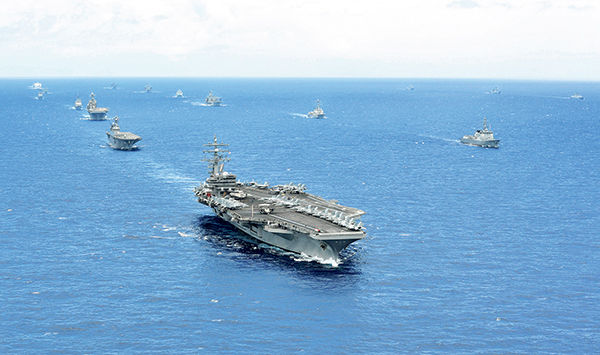LIHUE — Participants of the 2014 Rim of the Pacific left Hawaiian waters and headed back to their home nations. The world’s largest international maritime war exercise, known commonly as RIMPAC, concluded Friday. In total, 22 nations, 49 surface ships,
LIHUE — Participants of the 2014 Rim of the Pacific left Hawaiian waters and headed back to their home nations.
The world’s largest international maritime war exercise, known commonly as RIMPAC, concluded Friday. In total, 22 nations, 49 surface ships, six submarines, more than 200 aircraft and 25,000 personnel participated in this year’s event.
Capt. Bruce Hay, commander of Kauai’s Pacific Missile Range Facility, said that while the economic impact of RIMPAC is most often discussed, he is more interested in the fact that Kauai’s Navy base is the location for all the high profile, complex training events.
“The professionalism and aloha are hallmarks of the team here and the reason non-traditional participants like Norway and France come to the exercise,” he said in a statement.
Hay traveled to Oahu July 31 to attend RIMPAC closing ceremonies, hosted onboard the nuclear-powered supercarrier USS Ronald Reagan, which included a trophy to the winner of the “Naval Gun Fire Rodeo,” an exercise to determine most accurate targeting, according to PMRF spokesman Stefan Alford.
Approximately 19 ships from various countries, including the United States, China, Norway, Singapore, India, Republic of Korea and Japan, participated in the exercise, which took place off Kauai’s coast and consisted of ships firing live rounds into a specific set of coordinates.
“The Naval Surface Fire Support (NSFS) Rodeo trophy was awarded to USS MICHAEL MURPHY, DDG 112, a local Hawaii-based destroyer,” Alford wrote in an email.
Other activity around Kauai included helicopters and B-52 bombers flying overhead, warships dotting the horizon and the sinking of a decommissioned Navy vessel. Every two years, the monthlong RIMPAC exercise brings with it concerns from environmental groups that say it negatively impacts marine life, including endangered species. This year was no different as Oceans 4 Peace, a coalition consisting of Koholo Leo, The Surfrider Foundaiton Kauai Chapter, the Sierra Club Kauai Group, Kauai Alliance for Peace and Justice and People for the Preservation of Kauai, launched a campaign in protest of RIMPAC.
Gordon LaBedz of Surfrider called the campaign a “great success.”
“We had three educational events: movies, speakers, three roadside demonstrations and a very successful website,” he wrote in an email. “The RIMPAC radio ads … brought many phone calls to our RIMPAC phone hotline. We forwarded the calls to the proper agencies. We were grateful to the Hawaiian Humpback Whale Sanctuary for the quick response to the dying pilot whale in Hanalei.”
Two weeks ago, a 16-foot sub adult pilot whale washed ashore and died in Hanalei Bay. While some suspected the death may have been a result of naval activities, a Navy spokesman said at the time there is nothing to indicate that and it would be premature to speculate.
A team of scientists conducted a necropsy on the whale on July 26, but the examination did not produce results indicative of a cause of death. Tissue analysis intended to help determine the cause of death have been started and will take several weeks to months to produce, the National Oceanic and Atmospheric Administration said in a release.
Hay said the Navy was very pleased with the cooperative efforts of partner nations in the successful use of protective protocols for marine life.
“Our Navy has committed approximately $160 million over the past five years to marine mammal and sound in water research,” he said. “We are proud to be at the forefront to improve understanding of the behavior and abundance of marine mammals within and in near proximity to our water ranges.”
Hay said one of the common misconceptions for the Environmental Impact Studies done prior to large-scale exercises such as RIMPAC is the reference to allowable “takes.”
“Some people see a large number associated with that and assume a ‘take’ to be the worst-case scenario of a marine mammal death or injury, but the definition of a ‘take’ includes any temporary change in behavioral responses, such as foraging, feeding or migration pattern,” he said in a statement.
Hosted by U.S. Pacific Fleet from June 26 to Aug. 1, RIMPAC was led by U.S. Vice Adm. Kenneth Floyd, commander of the U.S. Third Fleet, and is designed to “enhance cooperation of the combined forces and improve individual war fighting competencies,” according to a release.


